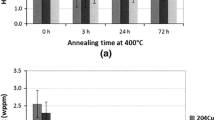The wear rate of hydrogenated specimens of high-nitrogen cold-worked manganese steels is five times larger than that of nonhydrogenated ones. In the absence of hydrogenation, the size of the wear products ranges from 25 to 40 μm at P = 400 N and from 40 to 100 μm at P = 500 N. For hydrogenated specimens, the size of the wear products is above 350 μm under a load of 250 N and ranges from 600 to 1000 μm at P = 400 N. The morphology of the wear products demonstrates an excellent microrelief, which indicates that fracture occurs by different mechanisms of fracture during the formation of a particle under friction conditions. On the products, we detected dimples in which, probably, particles containing σ-type intermetallics, carbides, and nitrides, which cause the initiation of cracks under both sliding friction and rolling friction, spalled.
Similar content being viewed by others

References
O. I. Balyts’kyi, V. O. Kolesnikov, and P. Kawiak, “Triboengineering properties of austenitic manganese steels and cast irons under the conditions of sliding friction,” Mater. Sci., 41, No. 5, 624–630 (2005).
V. V. Panasyuk (editor), Fracture Mechanics and Strength of Materials: A Handbook, Vol. 8: O. I. Balyts’kyi, O. V. Makhnenko, and O. O. Balyts’kyi, Strength of Materials and Durability of Structural Elements of Nuclear Power Plants [in Russian], Akademperiodika, Kiev (2005).
J. Romu, J. Tervo, H. Hännien, and J. Liimatainen, “Wear resistance of high nitrogen austenitic stainless steels manufactured by molten and powder metallurgy routes,” in: Proc. of the 3rd Int. Conf. High Nitrogen Steels HNS 93 [in Ukrainian], Kiev (1993), pp. 372–378.
H. J. C. Speidel, P. J. Uggowitzer, and M. O. Speidel, “Properties of cold-worked high-nitrogen chromium based alloys,” in: Abstracts of the 5th Int. Conf. on High Nitrogen Steels (May 24–26, 1998, Espoo, Finland), Stockholm (1998), p. 124.
O. I. Balyts’kyi and V. O. Kolesnikov, “Investigation of wear products of austenitic manganese cast irons,” Mater. Sci., 40, No. 1, 78–82 (2004).
O. I. Balyts’kyi, V. O. Kolesnikov, and J. Kubicki, “Enhancement of the crack resistance of manganese cast irons,” Mater. Sci., 41, No. 1, 67–73 (2005).
I. V. Kragel’skii, M. N. Dobychin, and V. S. Kambalov, Fundamentals of Calculations of Friction and Wear [in Russian], Mashinostroenie, Moscow (1977).
A. Balitskii, V. Kolesnikov, and J. Kubicki, “Capacity for strengthening of manganese doped iron—a reserve to increasing the exploitation stability of details for railway transport,” Ind. Tour. Transp., Issue 3, 29–38 (2004).
N. P. Sun, “The determination theory of wear,” Wear, 25, No. 1, 271–276 (1973).
E. A. Marchenko, On the Nature of Fracture of Surfaces of Metals in Friction [in Russian], Nauka, Moscow (1979).
O. I. Balyts’kyi, Modern Materials for High-Power Turbogenerators [in Ukrainian], Prostir-M, Lviv (1999).
G. P. Fetisov, Materials Science and Technology of Metals [in Russian], Naukova Dumka, Kiev (2001).
Author information
Authors and Affiliations
Corresponding author
Additional information
Translated from Fizyko-Khimichna Mekhanika Materialiv, Vol. 45, No. 4, pp. 93–98, July–August, 2009.
Rights and permissions
About this article
Cite this article
Balyts’kyi, O.I., Kolesnikov, V.O. Investigation of wear products of high-nitrogen manganese steels. Mater Sci 45, 576–581 (2009). https://doi.org/10.1007/s11003-010-9216-1
Received:
Published:
Issue Date:
DOI: https://doi.org/10.1007/s11003-010-9216-1



